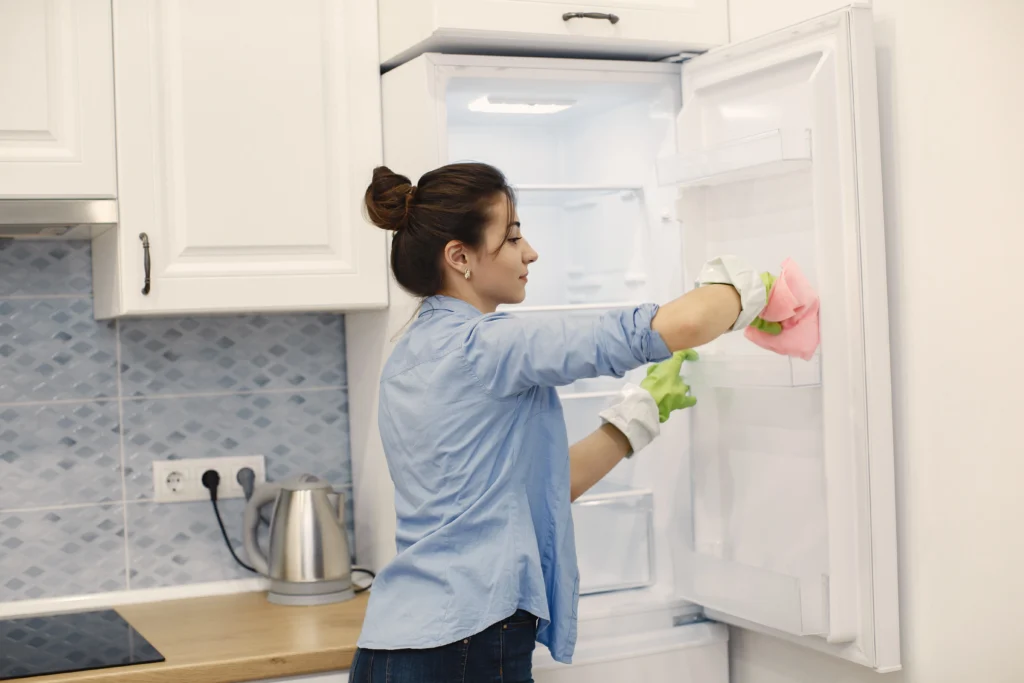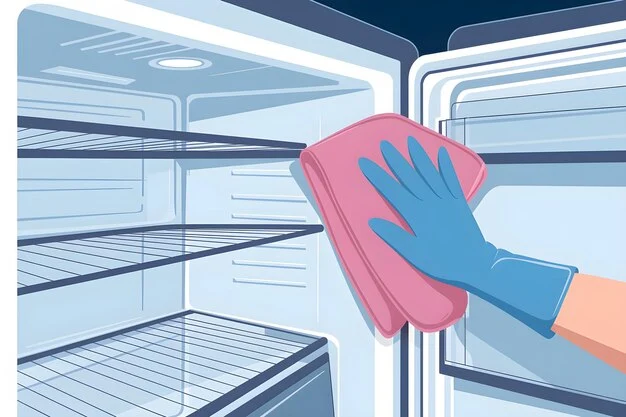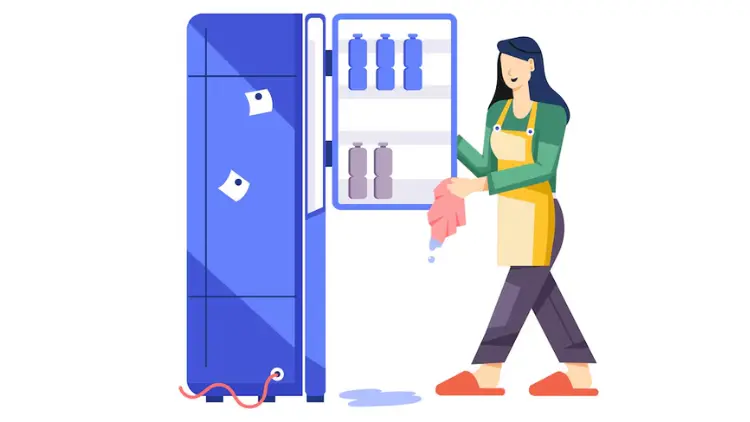Introduction
How you feel when you’re hungry and open up your fridge but couldn’t find anything to eat and one thing you find is an unpleasant thing called mold. The fridge is a place meant to preserve freshness, and can easily become a breeding ground for mold if spills, spoiled food, and moisture aren’t dealt with care and on time. Mold in your refrigerator isn’t just unsightly; it can contaminate your food, affect your health, and spread quickly if ignored.
We understand how you can feel seeing a mold in your fridge or in the freezer. That’s why we suggest you to follow the best solutions to clean the mold from the fridge. With the right methods like wiping with baking soda and water, disinfecting with vinegar, or using mild soap solutions you can remove mold safely and effectively. Mold is not restrained to the fridge only. It can take place anywhere in your home like a window or bathroom ceiling.
We bring this complete guide for you. In this complete guide, you’ll learn how to clean mold from your fridge step by step, why it happens, the safest cleaning products to use, and preventive measures to keep your fridge fresh and mold-free.
What Actually Is Mold?
Mold is a type of fungus that thrives in damp, warm, and poorly ventilated environments. It spreads through tiny spores that are invisible from the naked eye, and once these spores land on food or surfaces with moisture, they begin to multiply. Inside a refrigerator, mold can appear as fuzzy patches, slimy spots, or even dark discolorations on shelves and food. While some molds are relatively harmless, others can release toxins that may affect your health, especially if they contaminate your food. That’s why identifying and controlling mold early is so important.
Why Mold Grows in Your Fridge
Before diving into the cleaning process, it’s helpful to understand why mold forms inside refrigerators. Even though fridges are designed to keep food fresh, certain habits and conditions make them the perfect environment for mold to grow.

Common Causes of Moldy Fridge
There are many causes of your fridge being moldy. From our experience, root causes are as follows:
Spoiled or forgotten food
In the fridge, mold feeds on organic things like leftovers and expired food items. If any food is unnoticed in the back of your fridge, it becomes a breeding ground for mold.
Moisture buildup
Condensation, leaky containers, or even high humidity levels create damp spots leading to moisture build up, through which mold quickly spreads.
Poor Air Circulation
Overstuffing the fridge blocks vents and airflow, causing small pockets of warm, humid air that gives pump to mold to grow.
Unsealed containers
Storing liquids, fruits, or cooked meals without lids increases mold risks because the open surfaces attract spores that may lead to mold in your fridge.
Dirty Fridge Interiors
If spills, crumbs, and grease left uncleaned, they create a layer of food particles that mold can feed on.
In short, mold doesn’t “appear”, it grows slowly and eventually, when food and moisture are held together in an enclosed space. By understanding these causes, you’ll not only be able to clean mold from the fridge but also prevent it from coming back in the future.
How to Clean Mold from Your Fridge: Step-by-Step Guide

To begin with the cleaning mold from fridge, you will need to gather some supplies like-
- Rubber gloves
- Baking soda
- White vinegar or hydrogen peroxide
- Warm water
- Microfiber cloths or sponges
- Old toothbrush or scrub brush
- Spray bottle
- Garbage bags (for spoiled food)
Tip: Avoid using bleach inside your fridge as it can leave harmful residues and strong odors that may affect your food.
Step by Step Guide to Clean Your Moldy Fridge
Cleaning mold from your fridge may feel like a big task initially, but when broken down into simple steps, it’s completely manageable. Following are the steps you need to follow to clean a moldy fridge.
Step 1: Unplug the Fridge
Safety comes first. Always disconnect the fridge from the power plug before deep cleaning. This prevents electrical hazards and makes it easier to clean without the noise of a running motor.
Step 2: Empty the Fridge
Start with emptying the fridge
- Remove everything from your fridge, including spices, herbs and even small jars.
- Toss out any food that’s expired, visibly moldy, or smells suspicious.
- Place items at a cooler place to keep them fresh during the cleaning process, as the process might take a longer time than usual, if the amount of mold found is larger.
This ensures you will not put clean food back into a contaminated environment.
Step 3: Remove Shelves
- Take out all removable components like glass shelves, plastic bins, and drawers.
- Wash them separately in warm, soapy water or with a vinegar solution.
- Rinse thoroughly and let them dry.
Pro-Tip: If there’s stubborn mold on shelves, soak them in the sink with a vinegar-water mix for 15–20 minutes.
Step 4: Prepare Your Cleaning Solution
Skip the harsh chemicals as it may leave strong residues near your food. Instead, try natural mold-removing options:
- Vinegar solution: Mix equal parts white vinegar and warm water in a spray bottle.
- Baking soda paste: Combine baking soda with enough water to form a spreadable paste.
- Hydrogen peroxide (3%): Use undiluted for stubborn mold patches.
Step 5: Scrub Interior Surfaces
- Spray your chosen solution generously on fridge walls, door seals, and corners.
- Let it be for 5–10 minutes to break down mold growth.
- Use a microfiber cloth or soft scrub brush to wipe away mold.
- Use a toothbrush where you find it difficult to clean, like a small place in your fridge.
Step 6: Rinse and Dry
- Wipe down the surfaces with a clean cloth to remove leftover solution.
- Follow up with a dry towel to make sure no moisture lingers—remember, mold thrives in damp areas.
7th Step : Place Your Shelves Back and Plug Back In
- Once shelves and bins are completely dry, put them back in place.
- Plug in the fridge with the power button and wait for it to reach the right temperature.
- Restore your food, making sure everything is sealed and organized to reduce future mess.
With these steps, your fridge will not only look spotless but also feel fresher, healthier, and safer for your food.
Is Mold in Your Fridge Dangerous?
The answer may already be known to you. Mold in your fridge impacts your health, your food safety, and even the way your fridge functions. Many people think wiping away the visible mold is enough, but the real danger lies in the invisible spores that spread throughout your fridge and may be into your food as well. Possible reasons why mold is harmful or dangerous must be:
Food Contamination
Mold spores don’t stay still. Once they start growing on one thing, it can quickly travel to nearby leftovers, and even sealed packages. This cross-contamination not only wastes food but also makes it unsafe to eat.
Health Concerns
Breathing in mold spores can trigger health problems, especially for children, seniors, or anyone with asthma or allergies. Common symptoms include sneezing, coughing, watery eyes, and even skin irritation. In some cases, exposure to certain molds can lead to more serious respiratory issues.
Unpleasant Odors
Even after you toss out the spoiled food, that musty smell can linger inside the fridge. This odor seeps into other food items even if it is a fresh meal, making them taste bad or smell off, which means it leads to more food wastage.
Ignoring mold in your fridge doesn’t only ruin your groceries, it compromises your family’s health and comfort. That’s why learning how to properly clean a moldy fridge is so important for every household. It helps in preventing fridge mold for future days. Not only this, it will add a sparkle to your kitchen and especially if you have white kitchen cabinets and black countertops in your kitchen.
Special Attention: Cleaning Mold from Rubber Seals

The rubber door gasket (the flexible seal around your fridge door) is often overlooked, yet it’s one of the most common places for mold to hide and grow eventually. Because of its folds and constant exposure to air and moisture, it becomes the perfect breeding ground if not cleaned regularly.
Here’s how to tackle it:
Scrub gently with vinegar
Dip an old toothbrush into white vinegar and work it carefully into the folds of the gasket. This helps loosen and kill mold spores hiding in tight spots.
Dry thoroughly
After scrubbing, wipe the area with a clean, dry cloth. Moisture left behind can restart the mold cycle.
Prevent future growth
Lightly sprinkle a bit of baking soda along the seal. It acts as a natural moisture absorber and helps keep mold from coming back.
Pro Tip: Make cleaning your fridge seals part of your regular fridge wipe-down. A few minutes of attention every month can save you from big cleanups later.
Natural vs. Chemical Cleaners: Which Works Best?
One of the trickiest questions people have while cleaning the fridge mold is: Should I use natural cleaners or chemical products?
Natural Options
Natural solutions like vinegar, baking soda, and hydrogen peroxide are the top choices for fridge cleaning. They’re effective against mold, gentle on surfaces, safe around food, and eco-friendly. These solutions also leave behind minimal to no harmful residue, making them perfect for a food storage environment.
Chemical Cleaners
Products like bleach or ammonia are undeniably powerful against mold. However, they come with risks like strong fumes, potential food contamination, and even damage to fridge interiors if not used properly. If you do use them, you must rinse extremely well, and that’s something many people forgot while using the chemical cleaners.
As a cleaning expert, we suggest that for refrigerators, natural cleaning methods are the safest solutions. They’re tough on mold, gentle on your fridge, and better for your family’s health. You can use chemical cleaners for areas like bathrooms or outdoor surfaces, where food safety isn’t a concern.
Preventing Mold from Returning
Cleaning mold from your fridge is only half the job done, the real win is keeping it from coming back. Mold grows in damp, messy environments, so a few smart habits can go a long way in keeping your fridge fresh and safe.
1. Stick to a Regular Cleaning Schedule
Instead of waiting until things look (or smell) bad, make fridge cleaning part of your cleaning routine. A quick wipe of shelves, bins, and seals every two weeks or in month can stop mold growing before it even starts.
2. Store Food the Right Way
Fruits, and vegetables should always be put into airtight containers or fridge-safe bags. This not only prevents mold growth but also keeps food fresher for longer period of time.
3. Keep Moisture Under Control
Mold loves moisture. Avoid overstuffing your fridge, since poor air circulation creates damp pockets. And whenever there’s a spill or condensation, wipe it up immediately instead of “later.”
4. Add Natural Deodorizers
An open box of baking soda or even a small bowl of coffee grounds helps absorb excess moisture and odors. This creates an environment that’s much less welcoming for mold.
5. Stay on Top of Expiration Dates
Every week, do a quick scan of what’s inside. Toss anything that’s past its prime before it turns into a mold factory.
With these habits, your fridge stays not only cleaner and safer but also more energy-efficient and organized, giving you peace of mind every time you open the door.
Common Mistakes to Avoid When Cleaning Mold from a Fridge
Even with the best intentions, small mistakes can undo all your cleaning efforts. Here are the most common slip-ups to watch out for:
- Using bleach inside the fridge – While bleach kills mold, it’s too harsh for food storage areas. The fumes and chemical residue can linger and contaminate food.
- Skipping the door seals – Rubber gaskets are mold’s favorite hiding spot. If you miss them, the mold will likely return.
- Not drying completely – Leaving behind dampness creates the perfect environment for mold to grow back quickly.
- Putting food back too soon – Restocking before the fridge is fully dry traps moisture and restarts the cycle of mold.
Taking a little extra care with these details ensures your hard work pays off in a truly mold-free fridge.
When to Call Professional Cleaning Services
Sometimes, fridge mold is too stubborn or too extensive to tackle on your own. If you notice persistent black mold stains, a musty odor that doesn’t go away, or mold spreading into the cooling vents, it may be time to call in the experts.
Taking the help of professional cleaning services like Mesh Maids save you time. With the right cleaning and safest solutions, we deep clean even the trickiest spots in your fridge. We also offer interior fridge cleaning as an add-on service to regular house cleaning packages, saving you time and giving you peace of mind.
If you’ve tried DIY methods and the mold keeps coming back in your fridge, or if you’d simply prefer the reassurance of a thorough professional job, contacting us for scheduling a service can be the best long-term solution.
Conclusion
Mold in your fridge isn’t just an inconvenience—it can affect your health and your food’s freshness. Thankfully, knowing how to clean mold from your fridge step by step makes the process manageable and safe. By using natural solutions like vinegar, baking soda, and hydrogen peroxide, and the right steps you can remove mold effectively without exposing your food to harsh chemicals.
With regular cleaning, proper food storage, and moisture control, you can stop mold before it starts.
At Mesh Maids, we believe every clean home begins with a clean kitchen and your fridge is not an exception to it. With a little effort and the right approach, you can enjoy a fresh, mold-free fridge that keeps your food safe and your family healthy. Book with Mesh Maids to get a clean and a healthy kitchen.